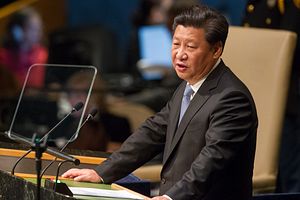On November 7, 2015, Ma Ying-jeou, officially identified as Taiwan’s “leader,” met with Mr. Xi Jinping, the “leader” of mainland China, in Singapore. This historic meeting was the first of its kind in the history of China.
On this special occasion, both sides agreed to address each other as “Mr.” (xiansheng) rather than by their official titles. For the Taiwanese, Ma is president of the Republic of China – that is his only official identity. To make their point, some Taiwanese reporters shouted out at Ma at the press conference using the title “President Ma.” In response, Ma stressed his identity as president of the Republic of China.
For the mainlanders, however, Xi’s identity is not that straightforward. At the press conference after the meeting, Zhang Zhijun, director of the Taiwan Affairs Office of the State Council of the People’s Republic of China, called Xi simply “Xi Jinping” — “Mr. Xi” probably sounded a bit strange for Zhang. Of course, this is not how Zhang usually addresses Xi. For Zhang, the most directly relevant of Xi’s titles is his role as the head of the Central Leading Small Group on Taiwan Affairs. But that title is not usable in public. Nor was it appropriate for Zhang to call Xi the “leader of the mainland.” That title is used by the Taiwanese.
So what title could Xi have used? In foreign affairs, Xi acts as the head of state and is usually identified as such. Before meeting Ma, Xi apparently had just concluded a very successful state visit to Singapore. Yet no one from the mainland addressed him as “President Xi” on this occasion. This is because of the “one-China” principle: Since the relationship between the two sides of the Taiwan Strait is not a relationship between two countries, it is not appropriate to call Xi “president.”
In the live interviews, CCTV hosts habitually addressed Xi as General Secretary of the Chinese Communist Party. In a sense, this is not accurate either. As of last year, Ma is no longer chairman of his political party, the Kuomintang (KMT). Therefore, the meeting on Saturday was not one between the leaders of the two political parties. President Ma’s counterpart was not General Secretary Xi, but President Ma’s counterpart could not be President Xi either.
The awkwardness of the titles is telling of a deeper issue. After having ruled mainland China for 66 years, the Chinese Communist Party leaders have yet to demonstrate their full confidence in the legitimacy of the government of the People’s Republic of China. On October 25, 1971 when the United Nations adopted a resolution to recognize the People’s Republic of China as the “only legitimate government of China to the United Nations” at the expense of the Republic of China, the PRC did not have a functional national government. Liu Shaoqi, who had served as president since April 1959, had been tortured to death less than two years earlier. Mao Zedong’s designated successor, Lin Biao, had just died in a plane crash in Outer Mongolia and been labeled a “traitor” merely 42 days earlier. One of Lin’s “crimes” had been his insistence that the PRC should create the office of state president in a newly revised constitution, against the wishes of Chairman Mao.
By having this first meeting between the president of the Republic of China and the president of the People’s Republic of China, it is fascinating to monitor how these two Chinas could peacefully work out a legitimate government of one China.

































